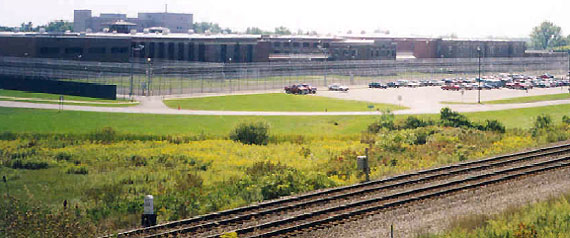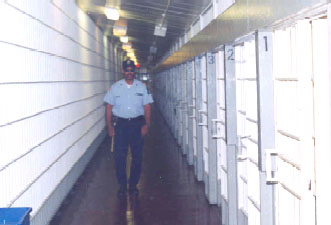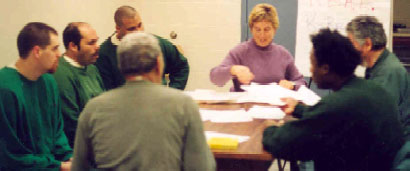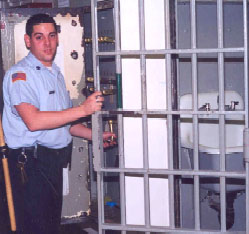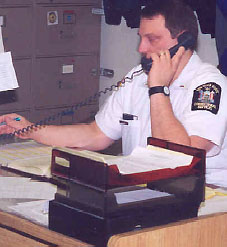WendeWende has been a maximum-security state prison for just 20 years. But this tract in western New York has penal roots that began growing before the Great Depression. Located in the town of Alden in Erie County, Wende was built on land originally purchased from the Holland Land Company by the locally-prominent Otto Wende family. The land was later donated to Erie County as a public park, later abandoned. The land was later operated as a farm to feed inmates in the Erie County Penitentiary on the west side of Buffalo. From those seeds sprouted the Erie County Penitentiary, precursor of today’s Wende prison. With residential expansion occuring in Buffalo, the decision was made around 1920 to relocate the Erie County Penitentiary from within the city limits. The Wende parcel was selected, and a new county jail opened there in 1923. By the 1980s, Erie County was looking to construct a new jail while the state sought additional maximum-security space.
An agreement was reached: Erie County would sell its Wende facility to the state, financing in part the county’s new jail that would be constructed on the same sprawling parcel in the town ofAlden. The state would renovate and expand the old jail into a state prison, providing much-needed cells in western New York. The original physical county jail plant in Alden was constructed in 1923-24. It followed a design by William Beardsley, a noted prison architect. Original construction was performed by Morris & Allen, Inc. A Buffalo Courier-Express article from July 13, 1923, reported, correctly, that the first round of inmates would be arriving the following day. The first building at the new county facility, constructed using inmate labor, was a combination – dormitory, kitchen and work area. In addition to farming, part of the work performed by inmates included making pine coffins that were used to bury the area’s indigent. The building is still in use today, housing the academic school and facility maintenance area. The architects of the Erie County Penitentiary were subsequently awarded a state contract to construct nearby Attica, which opened in 1931. The Alden parcel – originally donated by the Wende family – today houses not only the state prison bearing their name, but also the Erie County Home and Infirmary, the Erie County Correctional Facility and the state’s Buffalo Correctional Facility. With a growing inmate population necessitating an expansion of maximum-security prison beds in the early 1980’s, the state purchased the Erie County Penitentiary in 1983 from Erie County for $48 million. Erie County continued to share occupancy of the site until 1986, when construction of its new facility on the sprawling Wende grounds was completed. Beginning in 1983, the state expanded the former Wende penitentiary in phases. Phase I consisted of initial security measures and provisions for support services for the initial round of 185 male inmates. Phase II involved population expansion and associated security support programmatic enhancements. With the ultimate implementation of Phase III, which included new construction and renovation of existing buildings, Wende’s conversion to a state facility was complete. Today, the physical plant at Wende consists of 49 buildings. The facility encloses 15 acres within its secure perimeter.
The physical plant has changed dramatically. These changes include demolition of the old auditorium to provide space for a recreation/religious services building; demolition of the old power plant building inside the perimeter to allow for construction of a building for the state Office of Mental Health (OMH); construction of a new power plant and storehouse; construction of a new administration building; construction of a new range/training building; construction of a Quality ofWork Life building and construction of a RegionalMedical Unit (RMU). Wende houses three distinct inmate populations:
In addition, OMH also operates one of its 12 prison satellite units at Wende. The facility was accredited in 1988 by the American Correctional Association. . . It has been accredited triennially since . . . . . . . Wende has seen a 53 percent decline in the number of all unusual incidents since 1997, down from 329 to 153 in 2001. The number of inmate-on-staff assaults dropped by 63 percent between 1997 and 2001, falling from 57 to 21. Additionally, the number of inmate-on-inmate assaults fell by 61 percent between 1997 and 2001, from 51 to 20. One of Wende’s claims to fame is that it inaugurated the Department’s in-cell television program, a program which since has been expanded to seven other maximum-security facilities: Attica, Great Meadow, Clinton Main, Elmira, Five Points and the cadre units at Southport and Upstate.
This program involves general population inmates voting to limit package privileges, considered to be a substantial channel for contraband, for the opportunity to purchase for their cells 12-inch, black and- white television sets equipped with earphones. Inmates at the participating facilities are only allowed to receive packages on their birthdays and one other designated day during the year. Wende has been empowered with a wide variety of missions over the past two decades. . . . The maximum-security RMU, which opened in 1998, is a four-story building located within the secured perimeter. It contains an 18-bed infirmary for Wende’s primary care operation. The RMU also features 80 in-patient beds for those male inmates in western NewYork who are in need of coordinated speciality or long-term care. The RMU also includes a dialysis unit plus a physical therapy unit. Its clinical area provides space for on-site procedures as well as inmate evaluation sessions by community specialists versed in no less than 25 medical disciplines. Over the past several years, the five RMUs around the state have proven to be extremely cost-effective . . . . Security in hospitals throughout New York state also has been greatly enhanced due to fewer inmate trips and a corresponding decreased likelihood that inmates will act up in public and cause disruptions. The SNU is necessary to provide appropriate services to certain groups of inmates who exhibit limited intellectual abilities, poor coping skills, emotional problems and other maladies. . . . Wende’s SNU is self-contained except for specific services by medical, dental, religious, vocational, psychological, mental health and other such other services as determined by the Superintendent. The arrangement effectively shelters the client group from inmates in the rest of the facility 24 hours a day. This helps provide for a more secure facility and the establishment of an effective therapeutic environment.
Uniformed and non-uniformed personnel staffing the SNU at Wende are considered an integral and essential part of the program, and they participate in both Admission Screening Team and Treatment Team meetings. Additional mental health services are provided to Wende inmates under a cooperative agreement with OMH officials. An outpatient satellite unit from the Central New York Psychiatric Center in Marcy runs a mental health unit that features six observation cells, eight dormitory beds and 38 cells at Wende. OMH staff deliver a variety of mental health services (assessment, psychotherapy, psychotropic medicines, etc.) depending on an individual’s needs. The mental health unit staff are also responsible for the commitments of mentally ill inmates directly to Central New York. Wende also meets the needs of hearing impaired inmates. There are approximately 15 deaf and hearing-impaired inmates housed at the facility, and the number has been increasing. A manual communicator is on staff at Wende to provide assistance to these inmates. They use sign language to deal with all confidential information like disciplinary, medical, sick call, psychological services, counselor interviews and other issues. To further assist inmates with special needs, flashing fire alarms have been installed outside the cells of deaf and hearingimpaired inmates to afford them ample protections.Wende also features amplified phone equipment, personal amplification devices and closed-captioned television equipment. These reasonable accommodations and rehabilitative services are provided to inmates in need at Wende and other several state prisons pursuant to the requirements of the Americans with Disabilities Act (ADA).
As a designated reception center,Wende is also responsible for inmate transportation within the sprawling Wende hub. The facility has a fleet of 14 vehicles that it uses to transport inmates from facility to facility as needed. With the RMU on the grounds, the transportation staff is also required to transport inmates for medical services at outside hospitals when needed. In that regard,Wende is also responsible for providing security coverage for the secure ward at the Erie County Medical Center. Inmates from the 12 facilities that comprise theWende hub may be housed at the downtown Buffalo hospital when needed for surgery and other necessary medical treatment. In March of 2002,Wende opened its newly constructed Visitor Process Center. Volunteers from throughout the western New York community provide hospitality services to visitors to Wende during visiting hours on Saturday and Sunday. (As a maximum-security prison, Wende inmates can receive visitors seven days a week during authorized visiting hours). The center is designed to meet the needs of visitors, many of whom have traveled long distances . . . . At the end of 2001,Wende implemented a Residential Substance Abuse Treatment (RSAT) program. RSAT is similar to ASAT (the Department’s Alcohol and Substance Abuse Treatment program). However, it has a residential component that enhances the therapeutic effects. . . . The program is run by the facility’s RSAT Treatment Team, which consists of one Counselor and two Program Assistants. The program can service up to 120 inmates at any given time and utilizes trained and seasoned inmate program associates to serve its mission: to help inmates identify and better cope with addictive behavior. . . . Approximately 42,000 pounds of recyclable material are hauled to the recycling center at nearby Wyoming every month. The material consists of food, cardboard, tin, paper, plastics, clothes and wood. In 2001, the facility saved state taxpayers a substantial amount of money by recycling 512,110 pounds of waste. With a staffing complement of just over 800 employees, 527 of whom are security staff,Wende is a vital part of the community. . . . The facility recently was presented with an Award of Excellence from the United Way of Buffalo and Erie County for being one of the Top 100 Supporters of the United Way Community Care Fund. . . . This past year, Wende staff and inmates collected loose change and employees held several raffles, raising more than $500. Most of the money was used to buy new hats and mittens for the Harvest House Baby Ministry in Buffalo. And during a previous drive at Wende, employees donated over 200 items – which included toys, clothing, walkman radios and arts and crafts supplies – to children at the Roswell Park Cancer Center in Buffalo. . . .
On June 4, 2002 . . . two Wende employees were honored at the Department’s annual Memorial Service and Medals Ceremony at the DOCS Training Academy in Albany for meritorious service. . . . Governor Pataki presented the Medal of Honor, the Department’s highest honor, to Correction Officer Paul MacNeil . . . for the extraordinary action he displayed when responding to an inmate’s vicious assault on a fellow Correction Officer. CO MacNeil diverted the attention of the inmate and came under brutal attack himself. Despite his injuries, he was able to activate his personal alarm system and summoned further help. His actions prevented his co-worker from sustaining even more serious injuries. Also . . . Wende Plant Utilities Engineer Mark Battaglia received a Medal of Merit from Governor Pataki for his exceptional contribution to public service. He and two other civilians risked their lives to assist a local police Sergeant who was being assaulted by a motorist during a routine traffic stop in the village of LeRoy. Mr. Battaglia assisted the Sergeant without any regard for his own personal safety and helped prevent an ugly incident from escalating. . . . There currently are 190 registered volunteers from the local community who provide a wide variety of services at Wende on a regular basis. On average, there are 73 volunteers providing various services to the inmate population per month. Regularly scheduled volunteer groups include Alternatives to Violence (ATV), Alcoholics Anonymous (AA), Narcotics Anonymous (NA), Kairos, Residents Encounter Christ (REC) and various other religious and community organizations. . . . In recognition of these ongoing and selfless efforts, the facility each year hosts a typically well-attended volunteer recognition dinner . . . . Return to menu listing NYCHS excerpts of DOCS|TODAY Facility Profiles.
|
